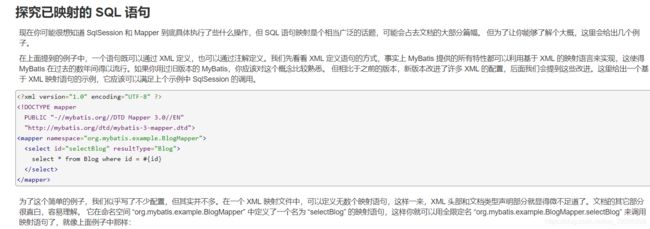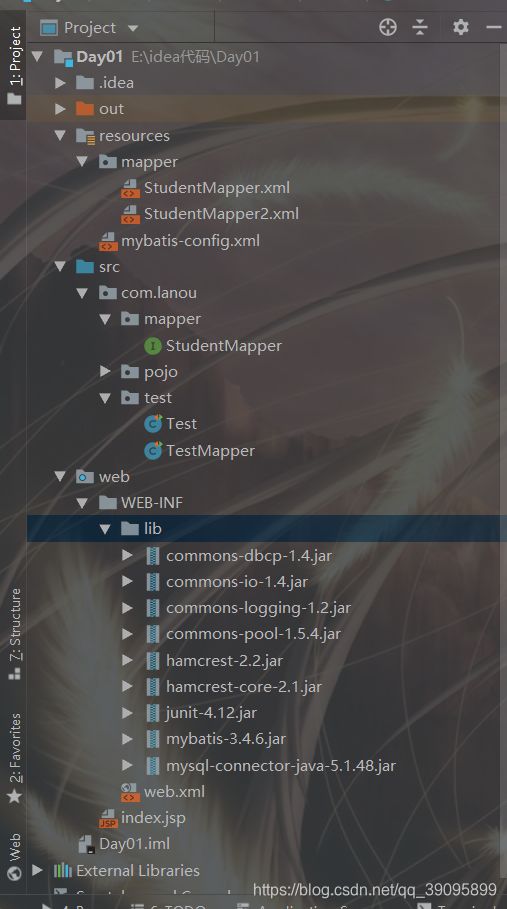mybatis框架基础入门
mybatis框架入门
三层架构
软件开发常用的架构是三层架构,之所以流行是因为有着清晰的任务划分。一般包括以下三层:
- 持久层:主要完成与数据库相关的操作,即对数据库的增删改查。 因为数据库访问的对象一般称为Data Access Object(简称DAO),所以有人把持久层叫做 DAO层。
- 业务层:主要根据功能需求完成业务逻辑的定义和实现。 因为它主要是为上层提供服务的,所以有人把业务层叫做Service层或Business层。
- 表现层:主要完成与最终软件使用用户的交互,需要有交互界面(UI)。
因此,有人把表现层称之为web层或View层。 三层架构之间调用关系为:表现层调用业务层,业务层调用持久层。 各层之间必然要进行数据交互,我们一般使用java实体对象来传递数据。
Mybatis 概述
mybatis是一个针对jdbc进行封装,一个优秀的持久层基于orm对象关系映射框架。它支持定制化 SQL、存储过程以及高级映射。MyBatis 避免了几乎所有的 JDBC 代码和手动设置参数以及获取结果集。MyBatis 可以使用简单的 XML 或注解来配置和映射原生类型、接口和 Java 的 POJO(Plain Old Java Objects,普通老式 Java 对象)为数据库中的记录。
名词解释:
持久层:就是指JDBC操作,把数据持久化到数据库中去;
orm对象关系映射:object(对象)、relational(关系)mapping(映射)就比如:数据库中的表一条记录对应java类中的一个对象,表中列名(字段名)对应Java实体类中的属性,这就是orm对象关系映射。
高级映射:同时查询多个表数据,并自动映射到类上。
定制SQL:自己写sql语句,是和hibernate框架做对比的,hibernate框架不需要自己写sql语句灵活性低。
存储过程:一级缓存,二级缓存
简单使用mybatis
mybatis学习官网
步骤一:创建项目
步骤二:导入jar包
commons-dbcp-1.4.jar
commons-io-1.4.jar
commons-logging-1.2.jar
commons-pool-1.5.4.jar
hamcrest-2.2.jar
junit-4.12.jar
hamcrest-core-2.1.jar
mybatis-3.4.6.jar
mysql-connector-java-5.1.48.jar
步骤三:创建实体类
import java.io.Serializable;
public class Student implements Serializable {
private String id;
private String name;
private Integer age;
//实现setXXX和getXXX方法
}
步骤四:在resources中创建mybatis-config.xml文件
在官网中找到这里复制到mybatis-config.xml
修改代码中的数据库配置如下:
<configuration>
<environments default="development">
<environment id="development">
<transactionManager type="JDBC"/>
<dataSource type="POOLED">
<property name="driver" value="com.mysql.jdbc.Driver"/>
<property name="url" value="jdbc:mysql://localhost:3306/mybaits"/>
<property name="username" value="root"/>
<property name="password" value="123456"/>
dataSource>
environment>
environments>
<mappers>
<mapper resource="mapper/StudentMapper.xml"/>
<mapper resource="mapper/StudentMapper2.xml"/>
mappers>
configuration>
步骤五:在resouces文件夹下创建sql映射问件
比如我先在resouces文件夹下先创建了一个mapper文件夹,再创建的StudentMapper.xml文件在官网上找到这里复制到

<mapper namespace="mapper.UserMapper">
<select id="selectStudent" resultType="com.lanou.pojo.Student">
select * from student where id = #{id}
select>
<select id="selectAll" resultType="com.lanou.pojo.Student">
select * from student;
select>
<insert id="saveStudent" parameterType="com.lanou.pojo.Student">
insert into student(id,name,age) values (#{id},#{name},#{age});
insert>
<update id="updateStudent" parameterType="com.lanou.pojo.Student">
update student set age=#{age} where id = #{id};
update>
<delete id="deleteStudent">
delete from student where id = #{id};
delete>
mapper>
步骤六:测试是否可以对数据库表中的student表进行增删改查
import com.lanou.pojo.Student;
import org.apache.ibatis.io.Resources;
import org.apache.ibatis.session.SqlSession;
import org.apache.ibatis.session.SqlSessionFactory;
import org.apache.ibatis.session.SqlSessionFactoryBuilder;
import org.junit.Before;
import java.io.IOException;
import java.io.InputStream;
import java.util.List;
public class Test {
SqlSessionFactory sqlSessionFactory =null;
public static void main(String[] args) throws IOException {
//定义mybatis核心配置文件
String resource = "mybatis-config.xml";
//将配置文件转换为输入流
InputStream inputStream = Resources.getResourceAsStream(resource);
//通过输入流生成会话工厂
SqlSessionFactory sqlSessionFactory = new SqlSessionFactoryBuilder().build(inputStream);
try (SqlSession session = sqlSessionFactory.openSession()) {
//执行查询
Student student = session.selectOne("mapper.UserMapper.selectStudent","A0002");
System.out.println(student.toString());
}
}
@Before
public void before() throws IOException {
//定义mybatis核心配置文件
String resource = "mybatis-config.xml";
//将配置文件转换为输入流
InputStream inputStream = Resources.getResourceAsStream(resource);
//通过输入流生成会话工厂
sqlSessionFactory = new SqlSessionFactoryBuilder().build(inputStream);
}
@org.junit.Test
public void selectAll() {
try (SqlSession sqlSession = sqlSessionFactory.openSession()) {
//执行查询
List<Student> stuList = sqlSession.selectList("mapper.UserMapper.selectAll");
System.out.println(stuList.toString());
}
}
/*
使用mybatis sqlsession dml
insert update delete 操作 不会自动提交事务
* */
@org.junit.Test
public void insertStudent(){
try(SqlSession sqlSession = sqlSessionFactory.openSession()){
//执行插入
Student stu = new Student("A0007","cxj",22);
int num = sqlSession.insert("mapper.UserMapper.saveStudent",stu);
System.out.println(num);
//提交事务
sqlSession.commit();
}
}
@org.junit.Test
public void updateStudent(){
try(SqlSession sqlSession = sqlSessionFactory.openSession()){
//执行修改
Student stu = sqlSession.selectOne("mapper.UserMapper.selectStudent","A0002");
stu.setAge(15);
sqlSession.update("mapper.UserMapper.updateStudent",stu);
//手动提交事务
sqlSession.commit();
}
}
@org.junit.Test
public void delectStudent(){
try(SqlSession sqlSession = sqlSessionFactory.openSession()){
//执行删除
int num = sqlSession.delete("mapper.UserMapper.deleteStudent","A0007");
System.out.println(num);
sqlSession.commit();
}
}
}
测试运行成功
我踩过的坑,要注意的点:
在测试执行语句时:命名空间.sql语句的id;
单元测试一定要导入junit.jar包,在方法上一定要加@Test
如果说什么没有找到xxx在核心配置文件中注册,一定要检查是否是引错sql映射文件了没
mybatis面向接口的开发
步骤一:在项目中创建一个dao接口
接口的命名跟sql映射文件命名尽量一样。
创建一个StudentMapper接口
import com.lanou.pojo.Student;
import java.util.List;
public interface StudentMapper {
//查询所有学生信息
public List<Student> selectAll();
//查询单个学生信息
public Student selectStudent(String id);
//修改某个学生信息
public int updateStudent(Student stu);
//添加一个学生信息
public int insertStudent(Student stu);
//删除某个学生信息
public int deleteStudent(String id);
}
创建一个sql映射xml文件如StudentMapper.xml
<mapper namespace="com.lanou.mapper.StudentMapper">
<select id="selectStudent" resultType="com.lanou.pojo.Student">
select * from student where id = #{id}
select>
<select id="selectAll" resultType="com.lanou.pojo.Student">
select * from student;
select>
<insert id="saveStudent" parameterType="com.lanou.pojo.Student">
insert into student(id,name,age) values (#{id},#{name},#{age});
insert>
<update id="updateStudent" parameterType="com.lanou.pojo.Student">
update student set age=#{age} where id = #{id};
update>
<delete id="deleteStudent">
delete from student where id = #{id};
delete>
mapper>
测试:
import com.lanou.mapper.StudentMapper;
import com.lanou.pojo.Student;
import org.apache.ibatis.io.Resources;
import org.apache.ibatis.session.SqlSession;
import org.apache.ibatis.session.SqlSessionFactory;
import org.apache.ibatis.session.SqlSessionFactoryBuilder;
import org.junit.Before;
import org.junit.Test;
import java.io.IOException;
import java.io.InputStream;
public class TestMapper {
SqlSessionFactory sqlSessionFactory = null;
@Before
public void before() throws IOException {
//定义mybatis核心配置文件
String resource = "mybatis-config.xml";
//将配置文件转换为输入流
InputStream inputStream = Resources.getResourceAsStream(resource);
//通过输入流生成会话工厂
sqlSessionFactory = new SqlSessionFactoryBuilder().build(inputStream);
}
@Test
public void selectStu(){
try(SqlSession sqlSession = sqlSessionFactory.openSession()){
//获取对应的StudentMapper接口
StudentMapper studentMapper = sqlSession.getMapper(StudentMapper.class);
Student student = studentMapper.selectStudent("A0004");
System.out.println(student.toString());
studentMapper.selectAll();
}
}
@Test
public void deleteStu(){
try(SqlSession sqlSession = sqlSessionFactory.openSession()){
StudentMapper studentMapper = sqlSession.getMapper(StudentMapper.class);
int num = studentMapper.deleteStudent("A0001");
System.out.println(num);
sqlSession.commit();
}
}
@Test
public void updateStu(){
try(SqlSession sqlSession = sqlSessionFactory.openSession()){
StudentMapper studentMapper = sqlSession.getMapper(StudentMapper.class);
Student stu = new Student();
stu.setId("A0005");
stu.setAge(25);
studentMapper.updateStudent(stu);
sqlSession.commit();
}
}
@Test
public void saveStu(){
try(SqlSession sqlSession = sqlSessionFactory.openSession()){
StudentMapper studentMapper = sqlSession.getMapper(StudentMapper.class);
Student stu = new Student("A0009","xxx",10);
studentMapper.insertStudent(stu);
sqlSession.commit();
}
}
}
注意:
面向接口开发中:接口的包名.接口名 =(对应) sql映射文件的命名空间。
接口中的方法 =(对应)sql映射文件中的sql语句的id;
增删改一定要提交事务:sqlSession.commit();不然数据库中没有数据
写语句的时候查询用查询标签,删除用删除标签,修改用修改标签,添加用添加标签。
项目的结构

